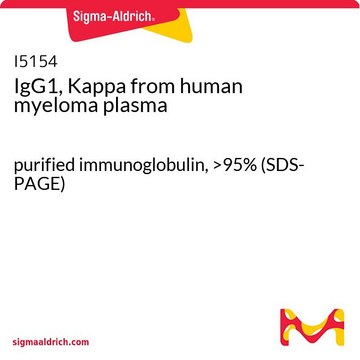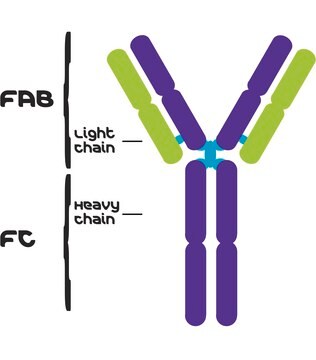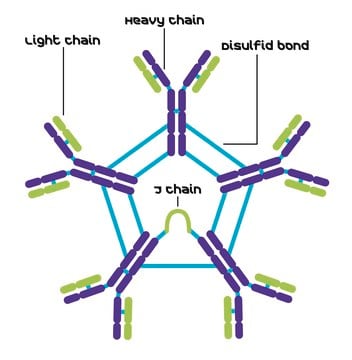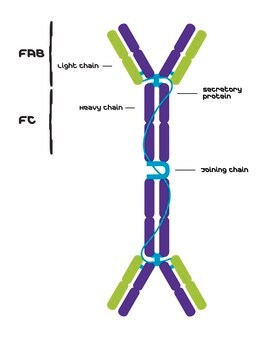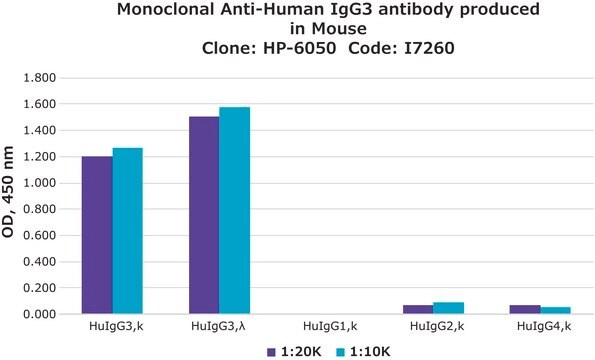I5654
IgG3, Kappa from human myeloma plasma
purified immunoglobulin, >90% (microfluidic capillary gel electrophoresis)
Sinonimo/i:
Human IgG3-κ
Autenticatiper visualizzare i prezzi riservati alla tua organizzazione & contrattuali
About This Item
Prodotti consigliati
Origine biologica
human
Livello qualitativo
Coniugato
unconjugated
Forma dell’anticorpo
purified immunoglobulin
Saggio
>90% (microfluidic capillary gel electrophoresis)
Condizioni di spedizione
dry ice
Temperatura di conservazione
−20°C
Cerchi prodotti simili? Visita Guida al confronto tra prodotti
Descrizione generale
IgG antibody subtype is the most abundant serum immunoglobulins of the immune system. It is secreted by B cells and is found in blood and extracellular fluids and provides protection from infections caused by bacteria, fungi and viruses. Maternal IgG is transferred to fetus through the placenta that is vital for immune defence of the neonate against infections. IgG3 is the has a unique extended hinge region conferring greater flexibility
Human myeloma IgG3, κ is purified from human plasma by fractionation, ion-exchange, and affinity chromatography procedures.
Human myeloma IgG3, κ is purified from human plasma by fractionation, ion-exchange, and affinity chromatography procedures.
Applicazioni
IgG3, kappa from human myeloma plasma has been used to determine the trisulfide levels in commercial therapeutic IgG1 antibodies and in human myeloma IgG1, IgG2, IgG3 and IgG4 antibodies.
The purified IgG3, κ may be used as an immunoglobulin calibrator, reference antigen, blocking agent or coating protein in a variety of immunoassays including ELISA, dot-blot immunobinding, Western immunoblotting, immunodiffusion, immunoelectrophoresis, hemagglutination, and cell-binding assays. Human myeloma IgG3 was for in flow cytometry in CHO cells.
Stato fisico
Solution in 20 mM tris buffered saline, pH 8.0.
Risultati analitici
The purity and identity are determined by immunoelectrophoresis, indirect ELISA and SDS-PAGE.
Esclusione di responsabilità
Unless otherwise stated in our catalog or other company documentation accompanying the product(s), our products are intended for research use only and are not to be used for any other purpose, which includes but is not limited to, unauthorized commercial uses, in vitro diagnostic uses, ex vivo or in vivo therapeutic uses or any type of consumption or application to humans or animals.
Codice della classe di stoccaggio
10 - Combustible liquids
Classe di pericolosità dell'acqua (WGK)
WGK 1
Punto d’infiammabilità (°F)
Not applicable
Punto d’infiammabilità (°C)
Not applicable
Scegli una delle versioni più recenti:
Possiedi già questo prodotto?
I documenti relativi ai prodotti acquistati recentemente sono disponibili nell’Archivio dei documenti.
I clienti hanno visto anche
Characterization of trisulfide modification in antibodies
Gu S, et al.
Analytical Biochemistry, 400(1), 89-98 (2010)
Rangaiah Shashidharamurthy et al.
Journal of immunology (Baltimore, Md. : 1950), 183(12), 8216-8224 (2009-12-17)
CD32A, the major phagocytic FcgammaR in humans, exhibits a polymorphism in the ligand binding domain. Individuals homozygous for the R allelic form of CD32A (CD32A(R) allele) are more susceptible to bacterial infections and autoimmune diseases as compared with H allelic
David R Martinez et al.
Cell, 178(1), 190-201 (2019-06-18)
The placental transfer of maternal IgG is critical for infant protection against infectious pathogens. However, factors that modulate the placental transfer of IgG remain largely undefined. HIV-infected women have impaired placental IgG transfer, presenting a unique "disruption model" to define
Masayuki Hirano et al.
Nature immunology, 8(7), 762-771 (2007-06-15)
Because functional analysis of Fc receptors (FcRs) relies heavily on mouse models, the identification of another Fcgamma receptor is particularly noteworthy. We demonstrate that FcgammaRIV, identified here as the mouse ortholog of primate FcgammaRIII, required association of the FcR gamma-chain
S Hashira et al.
Pediatrics international : official journal of the Japan Pediatric Society, 42(4), 337-342 (2000-09-15)
Maternal immunoglobulin G (IgG), transferred across the placenta to the fetus during intrauterine life, is an important component of the neonatal immunological defence mechanisms against infection. There is controversy with respect to differences in placental transfer of the different IgG
Il team dei nostri ricercatori vanta grande esperienza in tutte le aree della ricerca quali Life Science, scienza dei materiali, sintesi chimica, cromatografia, discipline analitiche, ecc..
Contatta l'Assistenza Tecnica.

